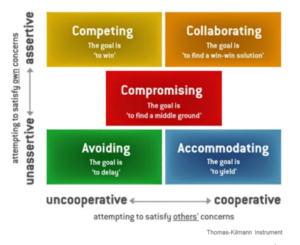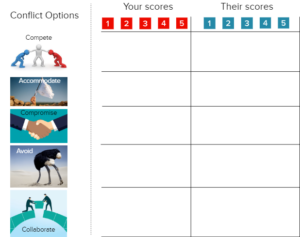In last week’s article I examined the impact of conflict on your brain and linked it back to sales plan execution. This week I’m going to provide you with five tips for mastering conflict using the GROW model. At its heart the approach provides you with a process that engages your prefrontal cortex early in the conflict and prevents the amygdala from hijacking it. With practice you can start to anticipate conflict early, thereby avoiding the damaging effects of all that cortisol flooding your system, not to mention protecting both your self-esteem and confidence.
And to help our coachees get into the right mindset we use a very famous coaching model called GROW, which we’ve adapted to different sales contexts, including execution and conflict management
GROW has 4 key components comprised of:
- GOAL setting
- Understanding the REALITY
- Deciding on your OPTIONS to achieve the Goal in the context of the Reality
- Planning your WAY FORWARD
Tip # 1
In a conflict scenario my first tip centres on the Goal. Crucially, it’s about considering both what your ultimate Goal is and also the other party’s Goal. Knowing your Goal gives you a focal point, around which you can contextualise all the conflicting emotions raging through your head. Equally, thinking about the other party’s Goal helps you balance your thinking out.
However, what we’ve discovered is that in a conflict situation, one of two things happens:
- You either go ‘me centric’ and just focus completely on what you want. That’s great but it’s only half the equation.
- Alternatively, you go the other way completely and just think about the other person’s goal and not even consider your own. At one level this looks great because you’re being totally Buyer-centric. However, great conflict resolution comes with considering both your and the other party’s Goal.
It’s no surprise that you get these extreme swings – at a brain level this is simply the manifestation of the amygdala highjack with ‘me’ representing fight, flight or freeze whilst ‘them’ represents a very real deep seated fear that they won’t achieve their own goals. However, for successful conflict resolution you need to consider both Goals.
Tip # 2
Consider the reality in which the conflict is being framed. For this to work well you need to consider both sides’ reality. However, just like the Goal, one or the other gets overlooked in a conflict situation; you either focus on your own reality or the other person’s. To successfully address the conflict, you need to consider both contexts.
However, when it comes to considering both realities, keep it short. I’ve seen it happen hundreds of times in a conflict situation when, even if you’re considering both sides, your brain will dump a whole mountain range of reality as you purge yourself of everything that led to, and maintains, the conflict. The problem here is that you can’t see the wood for the trees.
To avoid this and hopefully maintain some clarity, we recommend recording just five pieces of reality that are relevant to your Goal and five pieces of reality that you believe are relevant to the other party’s Goal. To help the process, keep asking yourself the questions:
- Is this piece of reality relevant to helping me meet my Goal?
- Is this piece of reality relevant to helping my counterpart meet their Goal?
Tip # 3
Once you’ve recorded both Goals and the reality in which they are to be delivered you can now start to consider your options. Our tip here draws on a very famous  conflict management approach developed by two American academics, Thomas and Kilmann back in the 70’s. Based on your levels of assertiveness and co-operation in a conflict, the model presents you with five options for resolving a conflict as follows:
conflict management approach developed by two American academics, Thomas and Kilmann back in the 70’s. Based on your levels of assertiveness and co-operation in a conflict, the model presents you with five options for resolving a conflict as follows:
- You compete
- You accommodate
- You avoid
- You compromise
- You collaborate

As the diagram illustrates, your choice depends on the levels of assertiveness or co-operation you choose to bring to the conflict. And these, in turn, depend on your Goal and the context in which the Goal is to be delivered.
To help you arrive at your optimum choice we recommend you score each option from 1-5 in the context of your goal. Where 1 is least likely to get you to your Goal and 5 is most likely to get you to your goal. When scoring, consider the five points of reality you’ve recorded. These will
have a bearing on your outcome. Now do the same for the other party. Score how you believe they will behave based on their Goal and their reality.
Once you’ve scored yourself and the other party you will have clarity on the optimum course to take because it will have been done in the context of your goal. Not what your emotions are telling you to do. In addition, you will also understand how your course of action will go down with the other party. It might be that there is complete alignment i.e., you will both compromise to meet your respective goal. Alternatively, it might be that your goal requires you to compete. Which is also fine if that helps you meet the goal
Tip # 4
My fifth tip touches on optioning and catches a lot of practitioners out – whether you’re willing to admit it or not, everybody has a default conflict resolution option which they subconsciously gravitate towards. Mine happens to be compromise – it’s partly my nature, I’m a people pleaser at heart so I’m always looking for the middle ground that accommodates the other party but ten years as a lawyer including five in the States showed me how wasteful conflict can be in terms of energy and money (lawyers are the only winners!).
This is neither a good thing nor a bad thing. You just need to be hyper aware of it when choosing your options which is where we go full circle back to your Goal. Choose your option based on your respective goals not your default conflict resolution option. I always double check my goal when scoring compromise as an option. Just to make sure that I’m pursuing that option for the right reasons.
Tip # 5
Finally, once you’ve chosen your option, you’re ready to proceed to the Way Forward. The tip here is really simple; take the first step. Often our practitioners sail through Goals, the Reality check and Optioning only to fall at the last hurdle – it’s clear why:
- The optimum option could be to compete and if you’re naturally a compromiser or collaborator, then even though this is the correct option, it can be tough to take the first step.
- If you’re naturally an avoider, then not doing anything is part of your modus operandi.
So, our tip is to write a five step plan to resolve the conflict, emphasis being on the ‘steps’. We’re talking about five simple actions that you can quickly do to get the ball rolling – remember, if the option you’ve chosen meets your goal, then this is the correct course of action for the right reasons and that will always be a comfort when calling the other individual to have that conversation.
If you need help practicing the tips, please email me at info@thefusebox.com – we have condensed the entire exercise into just one page!
For this week, I’ll leave you with a question, ‘what’s your default conflict resolution option; compete, compromise, collaborate, avoid or accommodate?’
Concerned about the impact that conflict is having on the mental fitness of your sales team? Contact me at info@thefusebox.com to explore a complimentary assessment and see how your organisation measures on the Sales Wellbeing Index.
#BUYERnomics #salesplanning #conflictasopportunity


